Ellis,J. Pressure transients in water engineering, A guide to analysis and interpretation of behaviour
Подождите немного. Документ загружается.

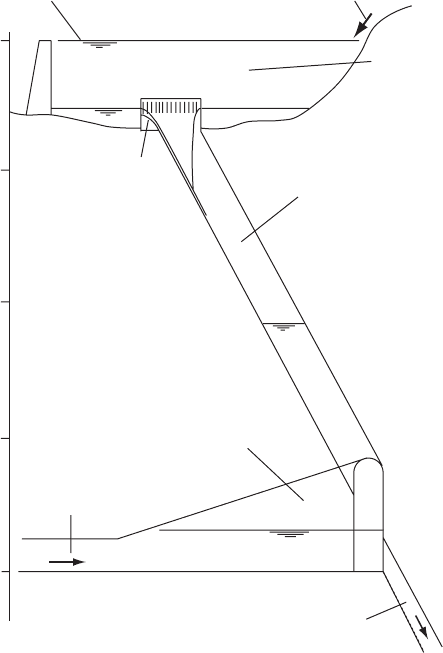
Having reached the gallery elevation, water level is largely stabilised
with an effective hydraulic gradient in the system to produce the
required acceleration or deceleration of flow.
Emptying and filling of galleries during transient events can introduce
further complications to analysis, in the form of surface waves in the
galleries as described by Ellis and Khairulla (1974). Control sections
can be introduced at the outfall from a gallery or at the connection
from a headpond as at Clachan HEP station (Fig. 14.2).
14.2 Simple analysis
The simplest model of a surge tank might include the following ele-
ments (Fig. 14.3). Conservation of volume within the tank dictates
232
M
M
M
M
Dam crest = 304.49 mAOD
Elevation = 285.0 mAOD
Inflow from Clachan burn
Surge pond
Intake and screens
cill = 302.36 mAOD
Inclined surge shaft
Surge gallery
Low pressure aqueduct
305
300
295
290
285
Steel-lined penstock to
underground generating station
Fig. 14.2. Underground surge chamber installation
Pressure transients in water engineering
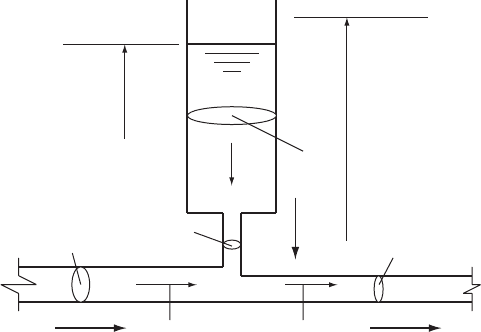
that:
V
u=s
A
u=s
A
t
dH
t
=dt ¼ V
d=s
A
d=s
ð14:1Þ
Head difference between the connection and the water surface
H
t
H is made up of two components: inertial head and head loss in
the connection, so that:
H
t
H ¼fK
L
þ 1gfA
t
=A
c
dH
t
=dtg
2
=ð2gÞþL
t
=g dV
t
=dt ð14:2Þ
where K
L
is the overall loss in the connection, A
t
is cross-section of the
chamber, A
c
is cross-sectional area of flow in the connection and
V
t
¼dH
t
=dt.
In addition the Cþ and C characteristics provide the following rela-
tionships at the time when the wave paths arrive at the tank connection:
V
u=s
þ g=a
u=s
H ¼ Jþ and V
d=s
g=a
d=s
H ¼ J
Four equations are available to solve for the unknowns, V
u=s
, V
d=s
, H
and H
t
. The above equations can be solved in a straightforward manner
with dH
t
=dt ðH
t
H
to
Þ=t.
14.3 Long connection to a chamber
Surge chambers can be large and in consequence there may be a signif-
icant time lag in their response. The above equation for conservation of
water volume in the tank assumes that there will be an immediate effect
233
Piezometric level in
pipeline at connection
Piezometric level
at water surface
M
+
+
+
V
u/s
A
u/s
A
d/s
A
c
A
t
V
t
H
t
H
V
d/s
Fig. 14.3. Definition sketch for surge shaft analysis
Surge tanks and related structures
upon water level in the chamber in the event of a transient event
arriving at the chamber connection. If the distance along the axis of
the chamber from the free surface to the connection is L
t
, then the pres-
sure wave reflection time will be 2L
t
=a. As already indicated in respect
to offsetting pressure vessels from a pipeline (Chapter 13), this can
allow time for part of a transient to bypass the connection before
there is a response from the chamber. This effect will be more significant
when the connection is of modest cross-sectional area A
c
and the
connection is relatively long. The effect will also be more significant
when the area of the surge chamber is modest and galleries provide
much of the volume. Response time will also vary with changing
water level in the surge chamber with the time for a pressure wave to
be reflected back from the free surface at its greatest when water
level is at its maximum.
Surge chambers have also been constructed using sections of pipe.
One example of this is at the Pao La Balsa scheme in Venezuela
where a tee was formed on the pumping main and a branch pipeline
laid on the hillside (Fig. 14.4). Sections of pipe may be laid on a
rising slope to provide a surge shaft. Because of the length of this
branch it is best modelled as an actual pipeline of variable length.
The pipeline is schematised in the usual way with head H
j
at the con-
nection to the rising main represented by the equation:
H
j
¼ 1=g
X
ðAJÞ
.
X
ðA=aÞð6:4Þ
Since cross-sectional areas are the same and wave speed is also
assumed common, this reduces to:
H
j
¼ a=g
X
ðJÞ=3 ð14:3Þ
At the free surface (Fig. 14.4), assuming the positive direction of flow to
be from the shaft into the pipeline, then for conservation of volume:
VA
p
¼A
s
dH
s
=dt ð14:4Þ
or averaging over a time increment t:
ðV þ V
o
ÞA
p
=2 ¼A
s
ðH
s
H
so
Þ=t
giving:
V þ V
o
¼2A
s
=ðA
p
tÞðH
s
H
so
Þ
Also from the characteristic arriving at the free surface:
V g=aH
s
¼ J
234
Pressure transients in water engineering
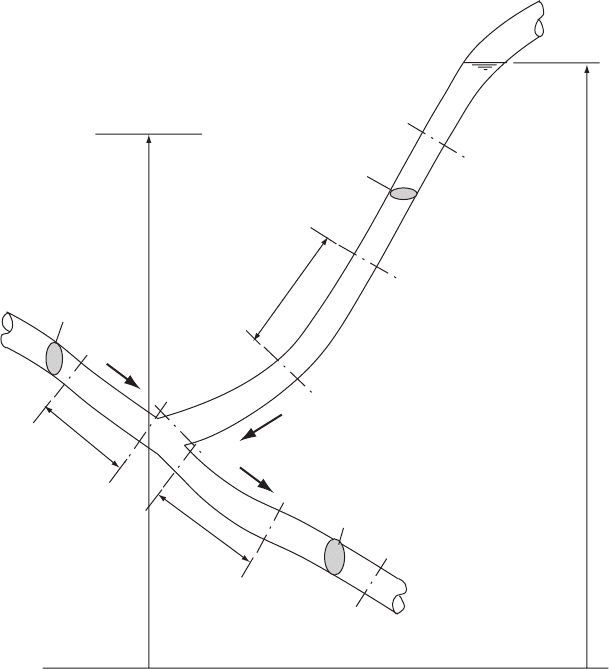
This neglects the inertia of that part of the water column above the first
computational section. Substituting for V in the conservation equation
at the free surface:
H
s
¼ð2A
s
=ðA
p
tÞH
so
JV
o
Þ=ð2A
s
=ðA
p
tÞþg=aÞð14:5Þ
Having found H
s
, the velocity at the free surface can be obtained from:
V ¼ Jþg=aH
s
In this way the response of the shaft is included and the effect of a
pressure transient partially bypassing the shaft can be modelled. Varying
water level in the shaft requires some method of identifying those
sections of shaft which are above water level and only the parts of
235
Common horizontal datum
+
+
+
H
t
H
j
Dx
Dx
Dx
A
p
A
p
A
p
Piezometric level at
the connection point
Piezometric level
at the free surface
M
Fig. 14.4. Inclined pipeline as a surge shaft
Surge tanks and related structures
the system below the water level included in the analysis. Where raw
or treated water is being handled there is also the possibility of allow-
ing some spillage from the top of the surge pipeline provided the loss
of water is acceptable and the spillage can be conveyed safely to a
convenient watercourse.
Dawson (c. 1980) described use of pipes as a form of surge tank in
sewage pumping applications. Clearly any spillage from the top of the
surge pipe has to be avoided and there is some risk of offensive
odours being vented when sewage level in the shaft is rising. Sizing of
the surge shaft requires consideration of possible septic conditions
developing if the sewage is allowed to dwell within the shaft for too
great a time. During downsurge the shaft must essentially empty.
Thus the shaft cannot have too great a capacity. On the other hand,
if too small a shaft volume is provided it may not fulfil its surge suppres-
sion function and violent oscillations may develop which could
adversely affect other parts of the system such as check valves.
14.4 Full-size connection
The choice of method of analysis is dependent upon the characteristics
of the shaft and connection. In the simple arrangement shown in
Fig. 14.5 where the connection is the full size of the surge chamber
then the ratio of head at the connection given by the equation:
H
j
¼ 1=g
X
ðJAÞ=
X
ðA=aÞð6:4Þ
to head H
v
¼ aV
o
=g at a downstream shut valve can be expressed as:
H
j
=H
v
¼ 2A=ð2A þ A
s
Þ
assuming a constant wavespeed. If A
s
A then H
j
will be small and a
simplified analysis which treats the connection to the surge tank as a
reservoir of constant water level may be sufficient. This was the tradi-
tional approach in the days before use of computer programs became
widespread. Where the connection is of modest size and appreciable
length it may be appropriate to use a more detailed approach.
14.5 Extent of protection
The surge tank does not offer 100% protection against pressure waves
arriving at the tank connection. Again, consider the simple arrange-
ment depicted in Fig. 14.5. The surge chamber is connected to a
pipeline such that the upstream and downstream sections of pipeline
236
Pressure transients in water engineering
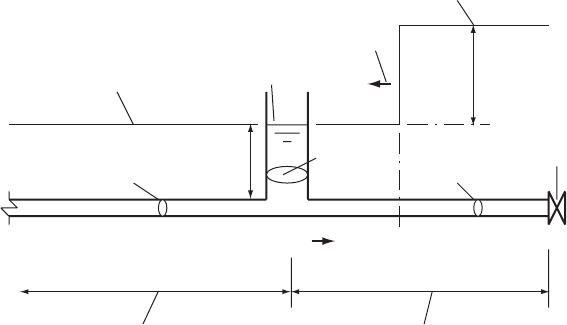
have wave propagation times much longer than in the surge tank itself
— that is, L
u=s
=a L
s
=a
s
and L
d=s
=a L
s
=a
s
. If a valve at the down-
stream end of the pipeline is abruptly closed with an initial steady
flow velocity V
o
the inertial head rise H
i
will be aV
o
=g as shown. The
pressure wave thus created will travel upstream to the surge chamber
connection at a rate dx=dt ¼ V a. At the connection the head rise
which occurs as the wave front arrives is given by:
H
j
¼fV
o
A ðV
o
ÞA þ 0A
s
g=f2A þ A
s
g
For simplicity, if a common wavespeed a is assumed for both pipeline
and surge shaft then:
H
j
¼ a=gV
o
2A=ð2A þ A
s
Þð14:6Þ
This head rise will induce a velocity V
s
into the surge chamber given by:
J
þs
¼ 0 ¼ V
s
þ g=aH
j
or
V
s
¼ 0 g=aH
j
¼g=aa=gV
o
2A=ð2A þ A
s
Þ
¼V
o
f2A=ð2A þ A
s
Þg ð14:7Þ
and an invariant value
J
s
¼ V
s
g=aH
j
¼2V
o
f2A=ð2A þ A
s
Þg ð14:8Þ
237
M
Upstream pipeline length
L
u/s
/a >> L
s
/a
s
Downstream pipeline length
L
d/s
/a >> L
s
/a
s
Steady flow piezometric level
Surge shaft
Inertia head rise
after valve closure
Valve
AA
A
s
V = V
o
V = 0.0
dx/dt = V – a
H
i
= a/gV
o
L
s
Fig. 14.5. Simple shaft with pressure wave
Surge tanks and related structures

At the water surface in the surge chamber it is assumed in the short
term that no significant change in water level has occurred so that head
remains constant at H
o
¼ 0. Velocity at the free surface is then:
V ¼ J
s
ð14:9Þ
and the invariant travelling from the free surface back to the surge shaft
connection is:
J
þs
¼ V ¼ J
s
¼2V
o
f2A=ð2A þ A
s
Þg
At the connection after time 2L
s
=a inertia head H
j
is now given by:
H
j2
¼ a=gð2V
o
A 2V
o
A
s
f2A=ð2A þ A
s
ÞgÞ=ð2A þ A
s
Þ
¼ a=gV
o
2A=ð2A þ A
s
Þ½1 2A
s
=ð2A þ A
s
Þ ð14:10Þ
Setting, 2A
s
=ð2A þ A
s
Þ¼A
the ratio of head rise H
j2
=H
j1
¼ 1 A
.
After subsequent wave reflections at intervals of 2L
s
=a, values of H
j
are
given by the sequence in Table 14.1.
The response of the surge shaft varies with the ratio A
s
=A and
Table 14.2 illustrates the influence of this ratio on the magnitude of
head rise at the shaft connection.
238
Table 14.1. Ratio of head rise after reflection to initial head rise at connection
Time from arrival
of pressure wave
Ratio of inertial head rise H
jn
=H
j1
at junction
01
2L
s
=a 1 A
4L
s
=a 1 2A
þ A
2
6L
s
=a 1 3A
þ 3A
2
A
3
8L
s
=a 1 4A
þ 6A
2
4A
3
þ A
4
10L
s
=a 1 5A
þ 10A
2
10A
3
þ 5A
4
A
5
12L
s
=a 1 6A
þ 15A
2
20A
3
þ 15A
4
6A
5
þ A
6
Table 14.2. Head rise at the shaft connection as a proportion of the head rise aV
o
=g
Time (2L
s
=a
increments)
A
s
=A ¼ 0:5 A
s
=A ¼ 1:0 A
s
=A ¼ 2:0 A
s
=A ¼ 4:0 A
s
=A ¼ 8:0
0 0.800 0.67000 0.5 0.33300 0.2000
1 0.480 0.22100 0 0.11100 0.1200
2 0.288 0.07300 0 0.03700 0.0720
3 0.173 0.02410 0 0.01230 0.0430
4 0.104 0.00800 0 0.00410 0.0260
5 0.062 0.00260 0 0.00140 0.0156
6 0.037 0.00087 0 0.00045 0.0093
Pressure transients in water engineering
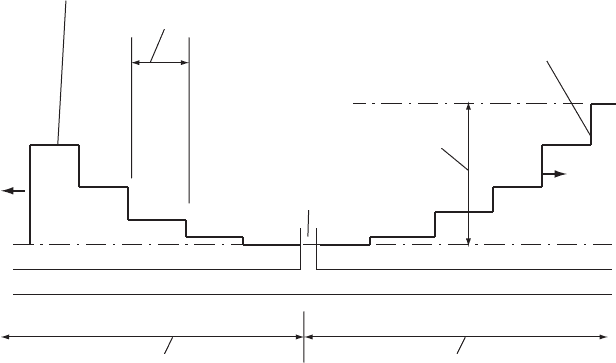
Due to the delay in surge shaft response, a pressure wave component
is able to travel into the upstream tunnel. As wave reflections
return from the free surface in the shaft to the connection with the
pipeline, relief of pressure occurs. The resulting compression wave
propagating upstream from the shaft connection has a form deter-
mined by the ratio A
s
=A as shown in Table 14.2. Figure 14.6
illustrates conditions subsequent to arrival of the initial pressure wave
from downstream.
14.6 Other aspects
Throttle arrangements can be employed in the connection to a surge
shaft in the same manner as at the inlet to a pressure vessel (Fig. 12.16).
Where the surge shaft is part of a system in which governing is
employed to maintain either a constant power output or a constant
flow rate, the stability of oscillations within the surge shaft should be
investigated. Jaeger (1977) describes in detail both the development
of stability criteria and their application.
Complicated surge chambers may involve a mixture of pressurised
flow coupled with some elements of free surface motion for example
(Fig. 14.2).
239
Pressure wave reflected
from surge tank connection
travelling downstream
Upstream pipeline Downstream pipeline
Surge shaft
Inertial head rise = aV
o
/g
2L
s
intervals
Pressure wave travelling upstream
from surge tank connection
Fig. 14.6. Pressure wave reflections from a surge shaft
Surge tanks and related structures
14.7 Initial estimates of surge tank parameters
Both graphical and analytical techniques have been developed to assist
the engineer in determining preliminary design parameters.
Fok (1980) prepared a quite comprehensive set of design charts for
surge tanks placed downstream of a pumping station on the discharge
line. His graphical approach allows pipeline resistance and the effects
of a differential throttle to be included subsequent to a power failure
at the pumping station. Peak transient piezometric level and minimum
level can be obtained together with their times of occurrence. Also the
maximum reversed flow rate can be obtained and the necessary time
delay before pumps may be restarted.
Considering a surge tank placed upstream of a hydropower station,
Jaeger (1977) presented some interesting analytical results for surge
tank behaviour following a turbine trip. He attributes the following
equations to work by Pra
´
s
ˇ
il and Eydoux (as cited in Jaeger, 1977). Start-
ing from the dynamic equation of mass oscillations in a pipeline or
tunnel, Pra
´
s
ˇ
il produced an equation for the highest water level in the
surge chamber. This equation was incapable of direct solution and
required use of tables. By making a simplifying assumption, Eydoux
was able to produce equation (14.11) which is capable of direct
solution.
z
max
¼ 1 2=3F
ro
þ 1=9F
2
ro
ð14:11Þ
where
z
max
¼ z=z
; z
¼ V
o
p
fLAt=ðgA
s
Þg and F
ro
¼ FV
2
o
=z
where z is measured from an upstream reservoir level as datum.
Equation (14.11) gives essentially the same result as the equation of
Pra
´
s
ˇ
il for values of F
ro
0:7. While intended for use with a surge
tank upstream of a turbine house, the same equation is equally applic-
able to a booster pumping station. It may be possible to use the same
analytical approach to produce an equivalent equation for a surge
tank downstream of a pumping station.
14.8 Related structures
Many instances exist of a chamber having a water surface in contact
with the atmosphere. Under transient conditions the water level in
such tanks will vary over time. The ability of the chamber to store
water or to act as a local reservoir for water can have beneficial effects
with respect to transient events. Range in tank water level requires to
240
Pressure transients in water engineering
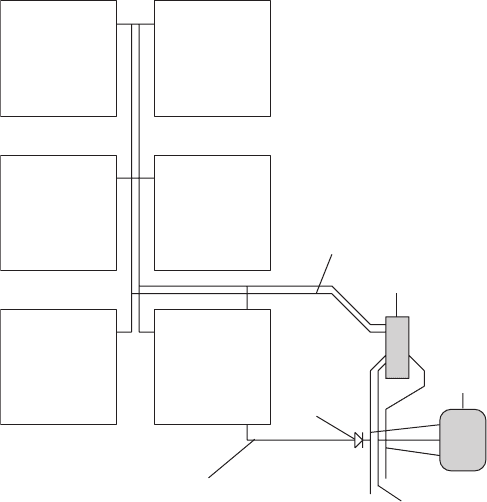
be established, both to prevent the chamber from overtopping and to
avoid air ingestion at low water levels. Usually range in water level
can be limited by increasing the surface area of a chamber but in the
case of sewage installations this may not be attractive as an enlarged
area of tank may provide greater opportunity for settlement and a
longer dwell time for sewage. Containment of maximum water levels
can be handled by providing an adequate freeboard. Some cases of
such chambers will be considered.
14.8.1 Service reservoir as a one-way surge tank
The pumping station and suction reservoirs of a large water distribution
scheme are shown in Fig. 14.7. Three rising mains, each DN 1200, are
connected to a surge vessel installation. In addition a bypass line, also
DN 1200, extends from reservoir No. 1 to a valve chamber from
which connections are made to the rising mains. The pressure vessels
provide initial surge suppression in the event of pumping failure but
should piezometric level in the rising mains at the connection fall
241
1
2
3
4
56
Surge
vessels
Pumping station
DN 1200 bypass
3 off DN 1200 risin
g
mains
2 off DN 1600 suction mains
NRV
Fig. 14.7. Service reservoir and bypass line
Surge tanks and related structures
